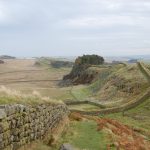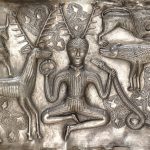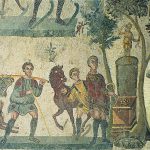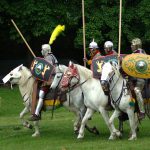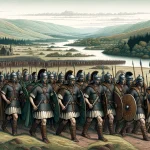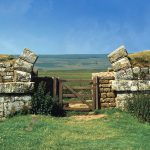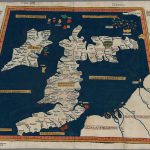Birrens (Blatobulgium) Roman Fort
Antonine Auxiliary Fort (AD 138–161)
Blatobulgium or Blatobvlgivm fort is a Roman Fort, located at the modern-day site known as Birrens, in Dumfriesshire, Scotland. The fort formed the northern terminus of the Roman-era Watling Street. The remains of this fort are quite impressive when approached from the south, where its southern defences, arranged along the edge of a natural scarp above the river are now covered in gorse bushes. The remains of stone-built buildings are visible across the whole of the interior, all beneath an overlying blanket of turf, except at the south-east corner, where several courses of stonework are visible; these belong not to the fort’s defences but to buildings in the retentura or rear of the camp, the corner-angle itself having been lost to erosion. The extensive ditch system and entrance causeway is especially prominent on the north, and a scatter of shaped stones on the west rampart marks the position of the gateway on this side.
Classical references for Blatobulgium Fort (Birrens)
The only classical reference for the name of the Birrens encampment is contained in the Antonine Itinerary of the late-second century. Iter II, “the route from the ‘Entrenchments’ to the port of Rutupiae, four-hundred and eighty-one thousand paces”, details the journey from Hadrian’s Wall to Richborough in Kent. In this itinerary the name Blato bulgio appears as the northern terminus, some 12 Roman miles from Castra Exploratorum (Netherby, Cumbria), both stations lying beyond the Wall of Hadrian.
The Blatobulgium Fort
RIB 2114 - Building inscription of the Twentieth Legion Victrix
The Twentieth Legion Victrix (built this).
Macdonald (loc. cit.) thought that Pennant’s reading was erroneous, since he knew no instance of the form legio XX Victrix. But this form, though rare as compared with Valeria Victrix, however abbreviated, is not without examples (see ILS index p. 459). Macdonald’s further conjecture that the stone, having been mistakenly read, might be identified with RIB 2061 (Bowness), should be noted, but not necessarily accepted R.P.W.
RIB 2112 - Building inscription of the Sixth Legion
The Sixth Legion Victrix (built this).
No commentary.
A lead sling-shot was uncovered during excavations at Birrens within a layer tentatively dated to the mid-second century, which likely means that the auxiliary garrison were trained in the use of this weapon, possibly at the suspected training camp at Burnswark nearby.
RIB 2110 - Dedication to Antoninus Pius
For the Emperor Caesar Titus Aelius Hadrianus Antoninus Augustus Pius, pontifex maximus, in the twenty-first year of tribunician power, four times consul, the Second Cohort of Tungrians, a thousand strong, part-mounted, publicly praised, (set this up) under Julius Verus, emperor’s propraetorian legate.
AN[...]NINO AVG [...]NT
MAX [...]IB POT XXI COS IIII
COH II [... ]R M[...]L EQ C L
SVB IV[... ] LEG AVG PR PR
For Cnaeus Julius Verus, governor of Britain about 155-about 159 (Birley in Askew Coinage 81), see Haverfield, PSAS 38 (1903-4), RIB 283 (Brough-on-Noe, Derbs.), 1132 (Corbridge), 1322 (Newcastle upon Tyne), CIL iii 8714 with 2732 (ILS 8974 with 1057).
When was the Blatobulgium Roman Fort (Birrens) Built?
The Dateable Pottery Evidence – Although there was plenty of pieces of South Gaulish decorated ware dateable to the Antonine period, there was absolutely no Flavian material.
The Blatobulgium Garrison
RIB 2093 - Altar dedicated to Fortune
To Fortune the First Nervan Cohort of Germans, a thousand strong, part-mounted, (set this up).
COH I
NERVANA
GERMANOR
ↀ EQ
No commentary. Addenda from RIB+add. (1995): The cohort is identified as the Antonine I garrison by a stratified fragment of an altar, JRS liv (1964), 178 No. 6.
The first unit to be stationed at Blatobulgium was very likely Cohors I Nerviorum Germanorum Milliaria Equitata, a one-thousand strong mixed unit of infantry and cavalry originally formed during the reign of emperor Nerva (96-98AD) from among the various Germanic tribes. This unit is attested on three inscriptions from the site; an altar to the goddess Fortune (vide RIB 2093 supra), an altar to Jupiter Best and Greatest (vide RIB 2097 infra), and another altar bearing a fragmentary dedication to an unknown deity (RIB 2116.B; not shown).
RIB 2092 - Altar dedicated to the Discipline of the Emperor
To the Discipline of the Emperor the Second Cohort of Tungrians, one thousand strong, mounted, publicly praised, (set this up).
AVG
COH II
TVNGR
MIL EQ C L
No commentary.
The second, and most frequently attested unit to be stationed at Birrens were the Second Cohort of Tungrians, a one-thousand strong part-mounted unit, originally recruited from amongst the Tungri tribe of Eastern Belgium. The name of this unit is recorded on no less than nine out of the twenty-four inscriptions so far recovered from the site.
This unit was probably in residence for a number of years, and, following losses due to battle or retirement, the garrison had to be bolstered by the addition of several small groups of Germanic tribesmen; many of whom brought their own peculiar deities to the Birrens fort.
RIB 2100 - Altar dedicated to Mars and to the Emperor's Victory
To Mars and the Emperor’s Victory the Raetian tribesmen serving in the Second Cohort of Tungrians, under the command of Silvius Auspex, the prefect, willingly and deservedly fulfilled their vow.
RIAE AVG C RAE
TI MILIT IN COH
II TVNGR CVI
PRAEEST SILVIVS
AVSPEX PRAEF
V S L M
cives Raeti: Birley shows that a vexillation of this cohort was serving in Raetia in A.D. 147, but moved probably back to Britain between 153 and 157. It is unusual to find a milliary cohort commanded by a prefect.For Silvius Auspex see RIB 2104, 2108.2. The genitive Aug(usti) is more frequent than the adjective Aug(ustae), for which there are several instances (ILS index p. 555).
RIB 2107 - Altar dedicated to Ricagambeda
To the goddess Ricagambeda (the men of) the Vellavian district serving in the Second Cohort of Tungrians willingly and deservedly fulfilled their vow.
BEDAE PAGVS
VELLAVS MILIT
COH II TVNG
V S L M
Holder s.v. Ricagambeda regards her as a Germanic goddess; Schönfeld Wörterbuch s.v. includes the name but provides no interpretation.
RIB 2108 - Altar dedicated to Viradecthis
To the goddess Viradecthis (the men of) the Condrustian district serving in the Second Cohort of Tungrians under Silvius Auspex, the prefect, (set this up).
THI PA[...]VS CON
DRVSTIS MILIT
IN COH II TVNGROR SVB SILVI
O AVSPICE PRAEF
1–2. For Viradecthis see CIL xiii 6486 (ILS 4759) Viroddi, CIL xiii 6761 (ILS 4758) Virodacti, CIL xiii 8815 (ILS 4757) [Vir]adecd[i]. 3–4. Condrustis: the Condrusi were a Germanic tribe lying between the Eburones and Treveri (Caesar B.G. vi 32, 1). 4–5. For Silvius Auspex see RIB 2100, 2104. Addenda from RIB+add. (1995): 1‒2. ILS 4757 was dedicated by [civ]es Tungri at Vechten.
The Second Cohort of Tungrians is also recorded on several altars at Castlesteads on Hadrian’s Wall, including at least one with the suffix Gordiana (RIB 1983), dated 241AD.
Deities Worshipped in Blatobulgium
RIB 2104 - Altar dedicated to Minerva
To the goddess Minerva the Second Cohort of Tungrians, a thousand strong, part-mounted, publicly praised, (set this up) under the command of Gaius Silvius Auspex, the prefect.
MINERVAE
COH II TVN
GRORVM
MIL EQ C L
CVI PRAEEST G SILV
AVSPEX PRAEF
For Silvius Auspex see RIB 2100, 2108.
RIB 2091 - Dedication to Brigantia
Sacred to Brigantia: Amandus, the engineer, by command fulfilled the order.
ARCITECTVS EX IMPERIO IMP
Miller, loc. cit., considers that Amandus can probably be identified with Val. Amandus discens (architectus) of leg. I Minervia cited on a building-inscription found at Iversheim, near Bonn, in Lower Germany, which can be dated to A.D. 209 (CIL xiii 7945, ILS 2459 corrected in corrig. iii, ii p. clxxviii).Architectus was a legionary grade, so presumably Amandus belonged to the Sixth Legion, based on York. If the identification is correct, Amandus, promoted to architectus and posted to Britain, erected the statuette presumably in the second or third decade of the third century, the period when the cult of Brigantia was being officially encouraged (cf. RIB 627 from Greetland, dated to A.D. 208). Addenda from RIB+add. (1995): There is no evidence that Birrens was occupied after c. a.d. 180, so the proposed identification of Amandus and the tentative Severan dating which results should be abandoned: CSIR i, 4. 12. Read instead: ‘Hadrianic-Antonine date?’
RIB 2109 - Altar dedicated to all the gods and goddesses
To all the gods and goddesses Frumentius, a soldier of the Second Cohort of Tungrians, (set this up).
ABQ
OMNIB
FRVMENT
IVS MIL COH II
TVNGR
No commentary.
RIB 2109 - Altar dedicated to all the gods and goddesses
To all the gods and goddesses Frumentius, a soldier of the Second Cohort of Tungrians, (set this up).
ABQ
OMNIB
FRVMENT
IVS MIL COH II
TVNGR
No commentary.
Other Roman Military Sites in the Area
There are several temporary camps in the neighbourhood of the Blatobulgium fort; 4 around Birrens itself (NY2174), 2 more at Middlebie nearby (NY2076) and a further 2 at Kirkpatrick-Fleming (NY2870) a short way along the road to the south-east. There is also a Roman fortlet and 2 practice works at Burnswark a little distance along the road to the north-west.
References for Blatobvlgivm
- Chronicle of the Roman Emperors by Chris Scarre (Thames & Hudson, London, 1995);
- The Roman Occupations of Scotland by B.R. Hartley in Britannia iii (1972) pp.1-55;
- The Roman Inscriptions of Britain by R.G. Collingwood and R.P. Wright (Oxford 1965);
Map References for Blatobvlgivm
NGRef: NY2175 OSMap: LR85
Roman Roads near Blatobvlgivm
NW (9) to Ladyward (Dumfries & Galloway) Iter II: ENE (15) to Castra Exploratorvm (Netherby, Cumbria) Military Road: SE (17) to Uxelodvnvm (Stanwix, Cumbria) Military Road: NW (3) to Bvrnswark Probable road: ESE (4) to Kirkpatrick N (19) to Raebvrnfoot
Sites near Birrens (Blatobulgium) Roman Fort
- Blatobulgium (Birrens) Vicus (0 km)
Vicus - Broadlea Temporary Camp 1 (0 km)
Marching or Temporary Camp - Broadlea Temporary Camp 2 (1 km)
Marching or Temporary Camp - Birrens Temporary Camp (1 km)
Marching or Temporary Camp - Middlebie Hill Temporary Camp (2 km)
Marching or Temporary Camp - Burnswark Training Camp 1 (5 km)
Marching or Temporary Camp and Practice Work - Burnswark Training Camp 2 (5 km)
Marching or Temporary Camp and Practice Work - Annan Hill Camp (10 km)
Marching or Temporary Camp - Annanfoot Camp (11 km)
Marching or Temporary Camp - Fairholm (11 km)
Fortlet
